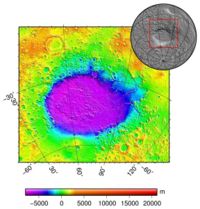Difference between revisions of "Crater"
| Line 14: | Line 14: | ||
Although tectonic activity on Mars is widely believed to be intermittent at best, evidence of it's volcanic past is evident in the many [[volcano]] craters littering the surface. The largest volcano caldera is the famous [[Olympus Mons]], the largest known volcano in the [[Solar System]]. | Although tectonic activity on Mars is widely believed to be intermittent at best, evidence of it's volcanic past is evident in the many [[volcano]] craters littering the surface. The largest volcano caldera is the famous [[Olympus Mons]], the largest known volcano in the [[Solar System]]. | ||
| − | == References == | + | == Ore resources == |
| + | On Earth, as probably on Mars, impact craters may be associated with areas of concentrated minerals. Large impact craters may leave the surface of the planet in a molten state for thousands of years. Heavier elements in the molten magma may separate out and sink to the bottom of the slowly cooling magma. Hot magma from a meteoritic impact may also evaporate some minerals, or favorize dilution in water, than can then rise to the surface and vent creating hot hydrothermal vents where minerals may concentrate. Similar vents may exist near vocanoes. | ||
| + | |||
| + | ==References== | ||
<references /> | <references /> | ||
[[category:Geologic Processes]] | [[category:Geologic Processes]] | ||
Revision as of 09:35, 16 November 2020
In it's broadest sense, a crater is simply a circular depression in the surface of a planet. Generally, in solar system geology, craters are formed either by meteorites or volcanic activity.
See the Mars Atlas map of craters and volcanoes.
Meteorite Impact

Hyper-velocity objects impacting the Mars surface cause highly energetic impacts, ejecting rock, dust and gases into the atmosphere and surrounding landscape. Most of Mars' cratering by meteorites was caused during the Late Heavy Bombardment period of the Solar System, over 3.9 billion years ago.[1] A large meteorite impacted the Mars surface around this time, creating the obvious Hellas Basin in the southern hemisphere.
The Martian dichotomy, between the old south and the new north has also been attributed to an immense impact crater early in the life of the planet. An alternative cause might be convective currents in the Early Martian Crust, causing an effect similar to the supercontinents that have existed on Earth through plate tectonics. The cooling of Mars would have interrupted these currents leaving a single supercontinent and a single ocean on Mars.
Volcanic Activity
Although tectonic activity on Mars is widely believed to be intermittent at best, evidence of it's volcanic past is evident in the many volcano craters littering the surface. The largest volcano caldera is the famous Olympus Mons, the largest known volcano in the Solar System.
Ore resources
On Earth, as probably on Mars, impact craters may be associated with areas of concentrated minerals. Large impact craters may leave the surface of the planet in a molten state for thousands of years. Heavier elements in the molten magma may separate out and sink to the bottom of the slowly cooling magma. Hot magma from a meteoritic impact may also evaporate some minerals, or favorize dilution in water, than can then rise to the surface and vent creating hot hydrothermal vents where minerals may concentrate. Similar vents may exist near vocanoes.






